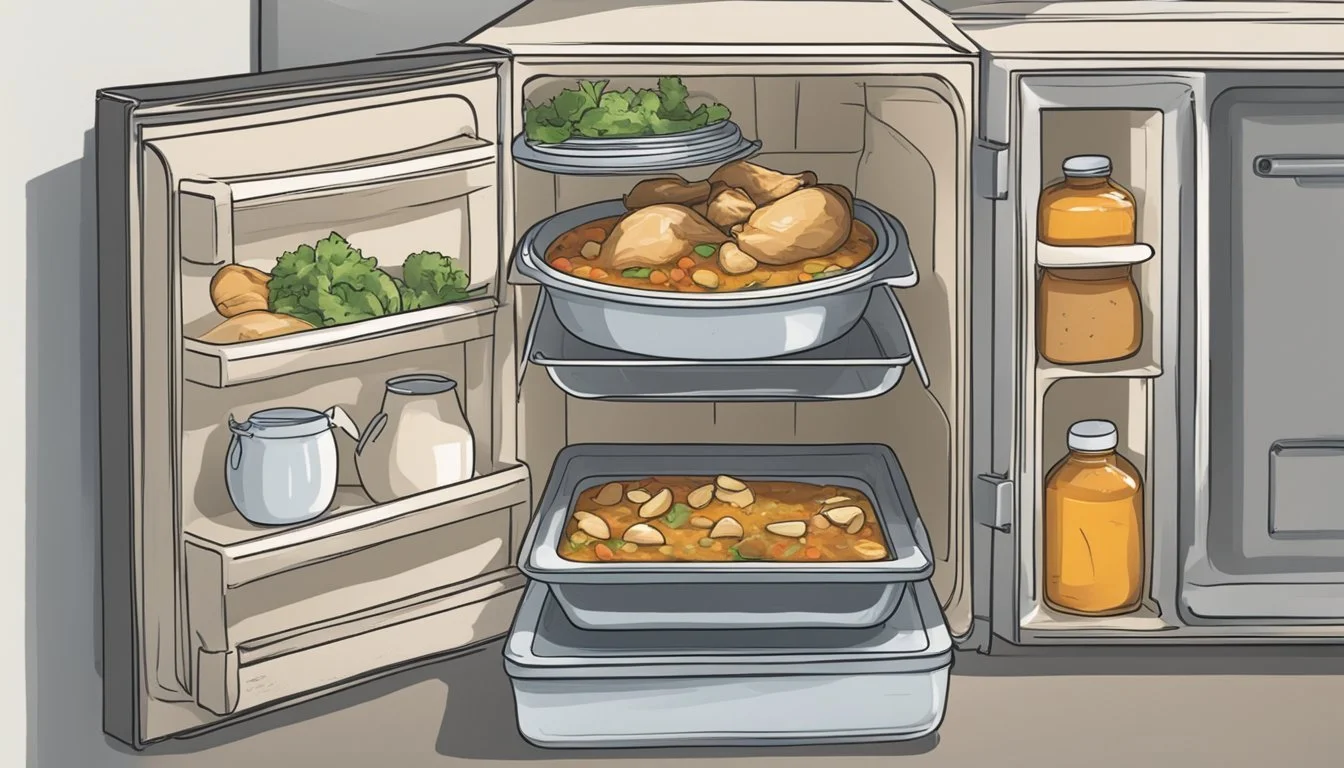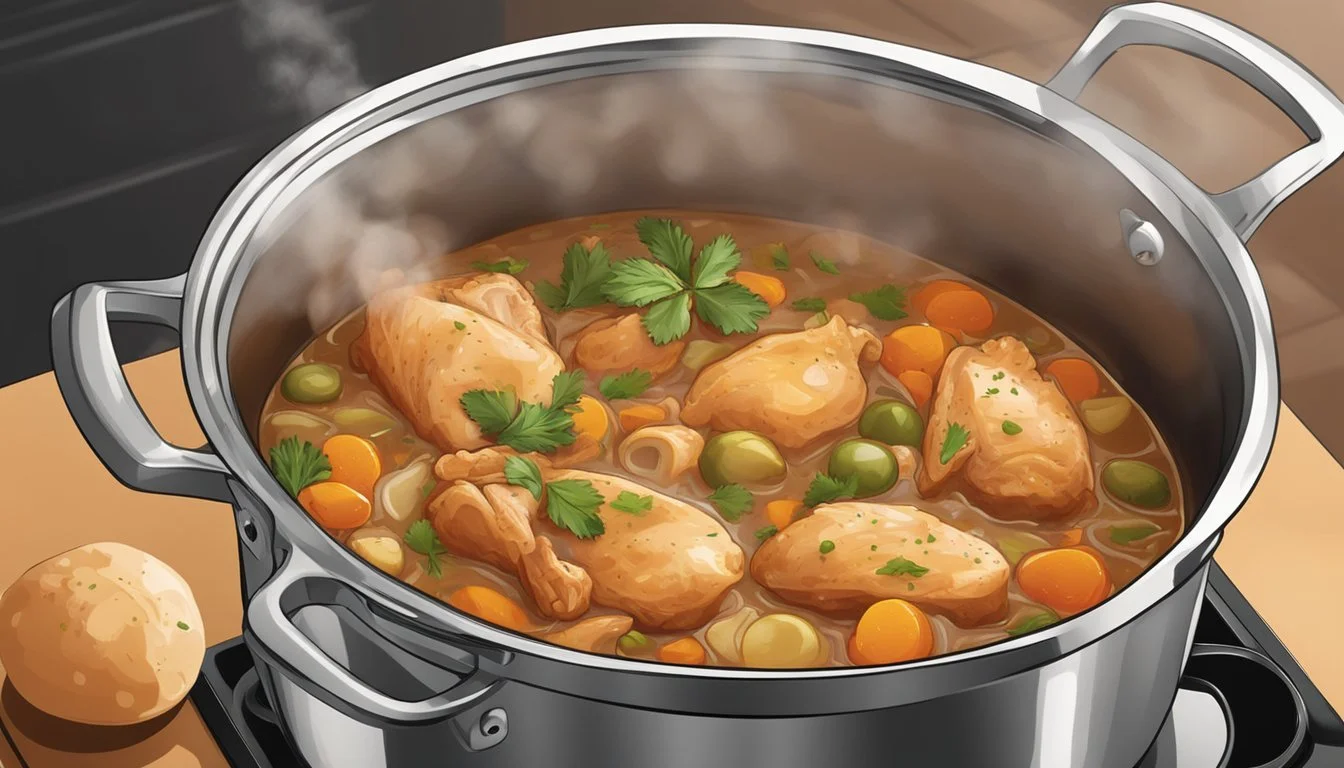How Long Does Chicken Stew Last?
Shelf Life and Storage Tips
Chicken stew is a staple comfort food that many love for its hearty and warming qualities. When stored properly, chicken stew can last in the refrigerator for about three to four days. This makes it a convenient option for meal prepping or enjoying leftovers.
Storing chicken stew correctly is crucial to maintaining its freshness and taste. Transferring the stew to an airtight container once it has cooled to room temperature helps prevent bacterial growth. If you need to keep it for longer, freezing is an excellent method, extending its shelf life up to three to four months.
Understanding the best practices for storing chicken stew ensures that you can enjoy this comforting dish safely and deliciously. Whether you prefer a classic recipe or a variation with different vegetables and spices, adhering to these storage tips will help you make the most of your homemade stew.
Understanding Chicken Stew
Chicken stew is a versatile and hearty dish featuring tender meat and a rich blend of vegetables simmered in a savory broth. Its flavor profile, cooking methods, and ingredient variations make it a beloved meal in many kitchens.
Composition and Ingredients
Chicken stew typically includes chicken thighs due to their rich flavor and tender texture. Other common ingredients include vegetables such as potatoes, carrots, onions, and celery. These vegetables not only add nutritional value but also enhance the stew's taste and texture.
The broth forms the stew's base, often made from chicken broth. Spices like thyme, bay leaves, salt, and pepper are essential to develop the stew's deep, comforting flavor. Olive oil is frequently used to sauté vegetables, adding a subtle richness to the dish.
Cooking Techniques
Various cooking techniques can be employed to prepare chicken stew. On the stovetop, the ingredients are sautéed and then simmered gently. This technique allows for careful monitoring and stirring to ensure even cooking.
Using a Dutch oven is another popular method, providing excellent heat distribution and retention. Additionally, the stew can be cooked in an oven, allowing it to maintain a consistent temperature throughout the cooking process.
For a more hands-off approach, a crockpot or slow cooker can be used. This method is beneficial for slow-cooking the stew over several hours, resulting in deeply infused flavors and incredibly tender meat.
Culinary Variations
Chicken stew offers a canvas for numerous culinary variations. Different regions may add unique ingredients or spices to put their twist on this classic dish.
Beef stew and pork stew are common alternatives, swapping chicken for other meats. For those seeking a meatless option, vegetarian stews incorporate hearty vegetables and beans, creating a satisfying meal without animal products.
Herb choices can also vary, with some recipes calling for rosemary or parsley instead of thyme. The addition of tomatoes, either fresh or canned, can add a tangy depth to the stew. These variations make chicken stew adaptable to diverse preferences and dietary needs.
Safe Storage Practices
Proper storage of chicken stew is crucial for ensuring its taste and safety over time. Using the right methods can help the stew last longer in the fridge and freezer without compromising quality.
Refrigeration Guidelines
To store chicken stew in the fridge, it should first be cooled to room temperature. This helps prevent condensation that can breed bacteria when it's stored warm. Transfer the stew to an airtight container. This step is important to maintain the stew's flavor and prevent contamination. Label the container with the date to track its freshness.
Chicken stew should be kept in the fridge at a temperature of 40°F (4°C) or lower. Under these conditions, it typically lasts for 3 to 4 days. Using shallow containers can help the stew cool faster, reducing the time it spends in the temperature danger zone (40°F to 140°F or 4°C to 60°C).
Freezing for Longevity
For longer preservation, chicken stew can be frozen. Begin by allowing the stew to cool to room temperature to minimize the risk of freezer burn. Portion the stew into freeze-safe airtight containers or freezer bags. Removing as much air as possible from the packaging helps preserve quality and taste.
Set the freezer temperature to 0°F (-18°C). Chicken stew stored this way can last up to 3 to 4 months, maintaining peak quality. Label each container with the date to monitor how long it has been stored. Regularly check the freezer to ensure it maintains a constant temperature, which is key for preventing freezer burn and maintaining food safety.
Identifying Spoilage
Chicken stew, like many other cooked dishes, can spoil if not stored properly. Here are some specific ways to recognize spoilage through visual, olfactory, tactile, and taste cues.
Visual and Olfactory Signs
Color: Discoloration is one of the first signs. Fresh chicken stew has a consistent color. A change to grey or greenish hues can indicate bacterial growth or mold.
Smell: A sour or off-putting smell is a clear indicator that the stew has gone bad. Fresh chicken stew typically has a savory aroma; any deviation suggests spoilage.
Mold Growth: Visible mold, which may appear as fuzzy patches or spots, is a definitive sign. Mold can develop in various colors, including white, green, or black.
Tactile and Taste Indicators
Texture: Fresh chicken stew should have a uniform, tender texture. Spoiled stew may develop a slimy or sticky feel. This change in texture points to advanced bacterial activity.
Taste: While tasting should be a last resort, an unnatural or sour taste indicates spoilage. The normal flavor profile of the stew should remain consistent.
Consistence: Changes in the stew’s consistency, where liquids separate and solid ingredients become mushy or overly firm, may suggest it has gone bad.
Proper Reheating Methods
Reheating chicken stew can be done effectively using various methods, each with its own set of instructions to ensure the best flavor and texture. Here’s a detailed look at microwaving, warming on the stovetop, and oven heating.
Microwave Reheating
Microwave reheating is convenient for small portions. Start by placing the chicken stew in a microwave-safe container. Cover the container with a microwave-safe lid or plastic wrap, leaving a small vent to allow steam to escape.
Heat the stew on high for 2-3 minutes, then stir thoroughly to ensure even heating. Continue to heat in 1-minute intervals, stirring in between, until the stew is hot throughout. **Use a food thermometer to check that the internal temperature reaches 165°F. This method is quick and retains most of the stew’s moisture.
Stovetop Warming
Stovetop warming is ideal for reheating larger quantities. Begin by transferring the chicken stew to a large saucepan or pot. Add a small amount of water or broth if the stew appears dry.
Set the burner to medium heat and cover the pot. Stir occasionally to prevent sticking. The stew should be heated for about 15-20 minutes or until it reaches an internal temperature of 165°F. This method helps maintain the stew’s flavors and textures and ensures even heating.
Oven Heating
Oven heating is suitable for uniform warming, especially for large batches. Preheat the oven to 350°F. Place the chicken stew in an oven-safe dish and cover it with foil to keep it moist.
Heat the dish for approximately 30-35 minutes. Stir once halfway through the process to promote even heating. You can add leftover dumplings during the last 10 minutes if desired. Confirm the internal temperature reaches 165°F before serving. Using the oven preserves the dish’s flavor complexity and prevents it from drying out.
Maximizing Chicken Stew Quality
Properly maintaining chicken stew quality hinges on key factors such as optimal storage conditions and handling practices. These elements can significantly extend the freshness and enjoyability of your meal.
Maintaining Ideal Conditions
Chicken stew should be stored in airtight containers to prevent air from spoiling the broth and ingredients. Using containers with tightly fitting lids is essential.
Keep the temperature of the fridge at or below 40°F (4°C). Refrigeration in these conditions can preserve the stew’s quality for 3-5 days. For longer storage, freezing is ideal. Ensure the stew has cooled to room temperature before freezing and store it at 0°F (-18°C).
Fat and cream in the stew can affect how long it stays fresh, so leaner recipes without heavy cream may last slightly longer.
Best Practices for Leftovers
Handle leftovers with care. Label containers with the date they were made to track freshness. Avoid leaving stew out at room temperature for more than 2 hours to prevent bacterial growth.
When reheating, make sure the temperature reaches 165°F (74°C) to ensure safety. Stir the stew to distribute heat evenly.
If planning to store leftovers for extended periods, portion them into smaller airtight containers before freezing. This allows for quick and even freezing and reduces the chances of freezer burn.
Following these storage tips will help maintain the freshness and flavor of your chicken stew, ensuring it stays delicious and safe to eat.
Enhancing Your Stew Experience
Elevate your chicken stew with the right sides and perfect wine pairings to create a memorable meal. Consider these ideas for complementing and enhancing the flavors of your stew.
Complementary Side Suggestions
Adding sides to chicken stew can make the meal more satisfying and balanced. Crusty bread is an excellent choice, providing a delightful texture contrast and perfect for soaking up the rich broth. Herbed flatbread infused with rosemary also pairs well with the flavors of the stew.
Fresh veggies like roasted carrots, steamed green beans, or a simple salad offer a crisp counterpoint to the hearty stew. Mashed potatoes or rice can be another filling addition, absorbing the stew's savory juices and adding to the overall dining experience.
Wine and Stew Pairings
Selecting the right wine can significantly enhance the flavors of your chicken stew. A light white wine like Sauvignon Blanc complements the delicate flavors of the chicken and vegetables, adding a refreshing acidity.
For a more robust pairing, consider a rosé. Its balanced acidity and subtle fruity notes enhance both the meat and the broth without overwhelming the dish. Additionally, wines like Chardonnay with a touch of oak can add complexity, highlighting the savory aspects of your chicken stew.
Chicken Stew Recipes and Variations
Chicken stew offers diverse options, each bringing unique seasonings, vegetables, and cooking methods. This section explores classic recipes, innovative twists, and international variations.
Classic Chicken Stew
Classic chicken stew typically features tender chicken, carrots, and peas, simmered in a savory gravy. Essential seasonings include salt, black pepper, and sometimes paprika for a slight kick.
A common preparation involves:
Browning chicken in a pot
Cooking onions, garlic, and other vegetables
Adding chicken stock and simmering
For thickening, roux or vegetable purees like mashed potatoes or carrots work well, giving the stew a hearty consistency.
Contemporary Twists
Modern variations of chicken stew incorporate exciting ingredients like zucchini or different seasoning blends. Often, these stews are cooked in one pot for convenience.
Newer recipes may use:
Coconut milk for a creamier texture
Different herbs such as thyme and parsley
Various vegetables like bell peppers or kale
Cream-based stews are also popular, often adding a rich, velvety texture by stirring in cream towards the end of the cooking process, ensuring the veggies and chicken come together beautifully.
International Flavors
International chicken stews introduce flavors from around the world, highlighting different spices and techniques.
Examples include:
Coq au Vin from France with red wine, mushrooms, and pearl onions
West African Chicken Stew, featuring tomatoes, peanut butter, and chilies
Mexican Chicken Pozole, using hominy, lime, and cilantro
These global dishes offer unique flavor profiles by incorporating local seasonings like paprika, various peppers, and even shellfish in some coastal recipes, providing vibrant and diverse culinary experiences.








